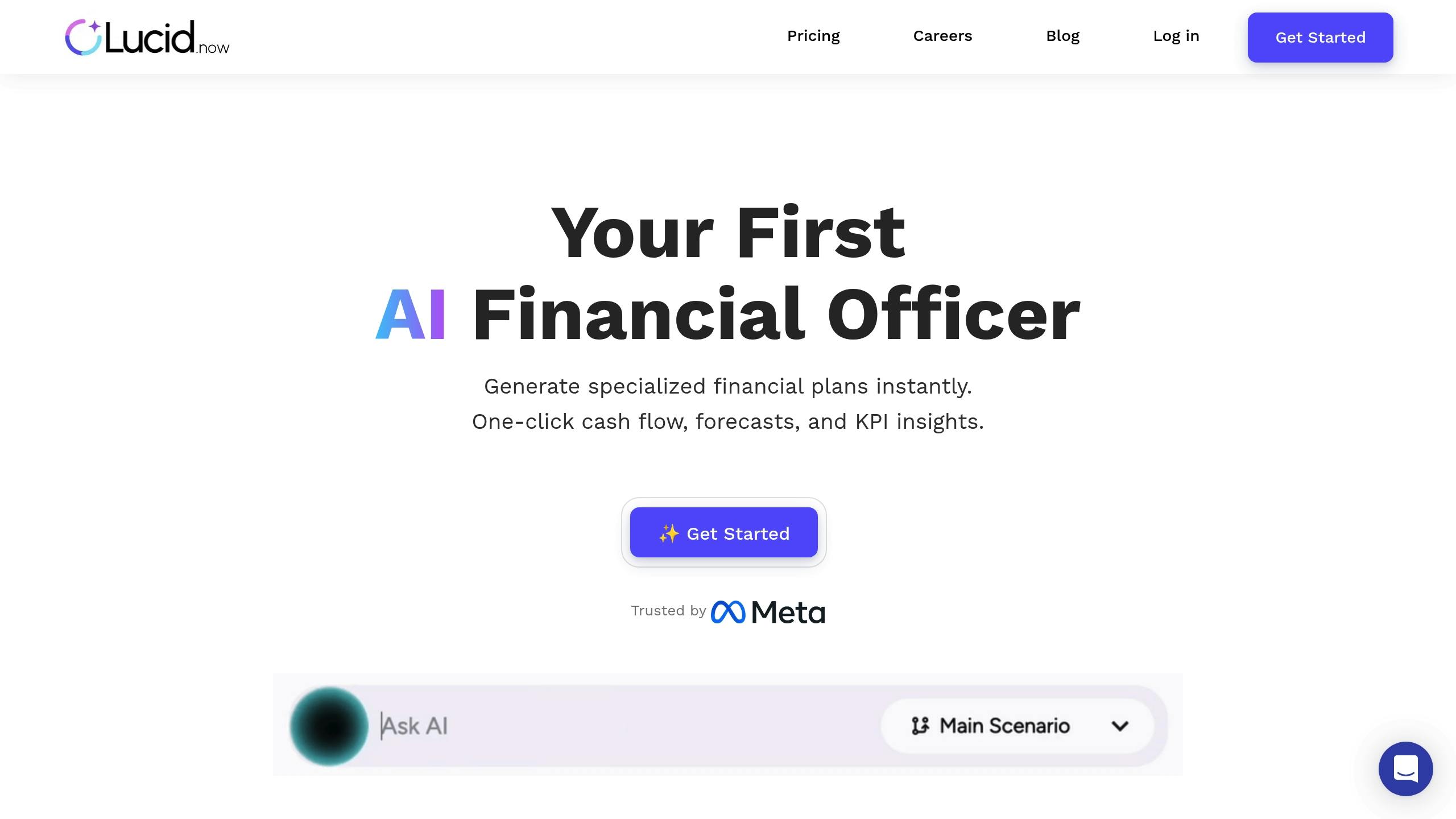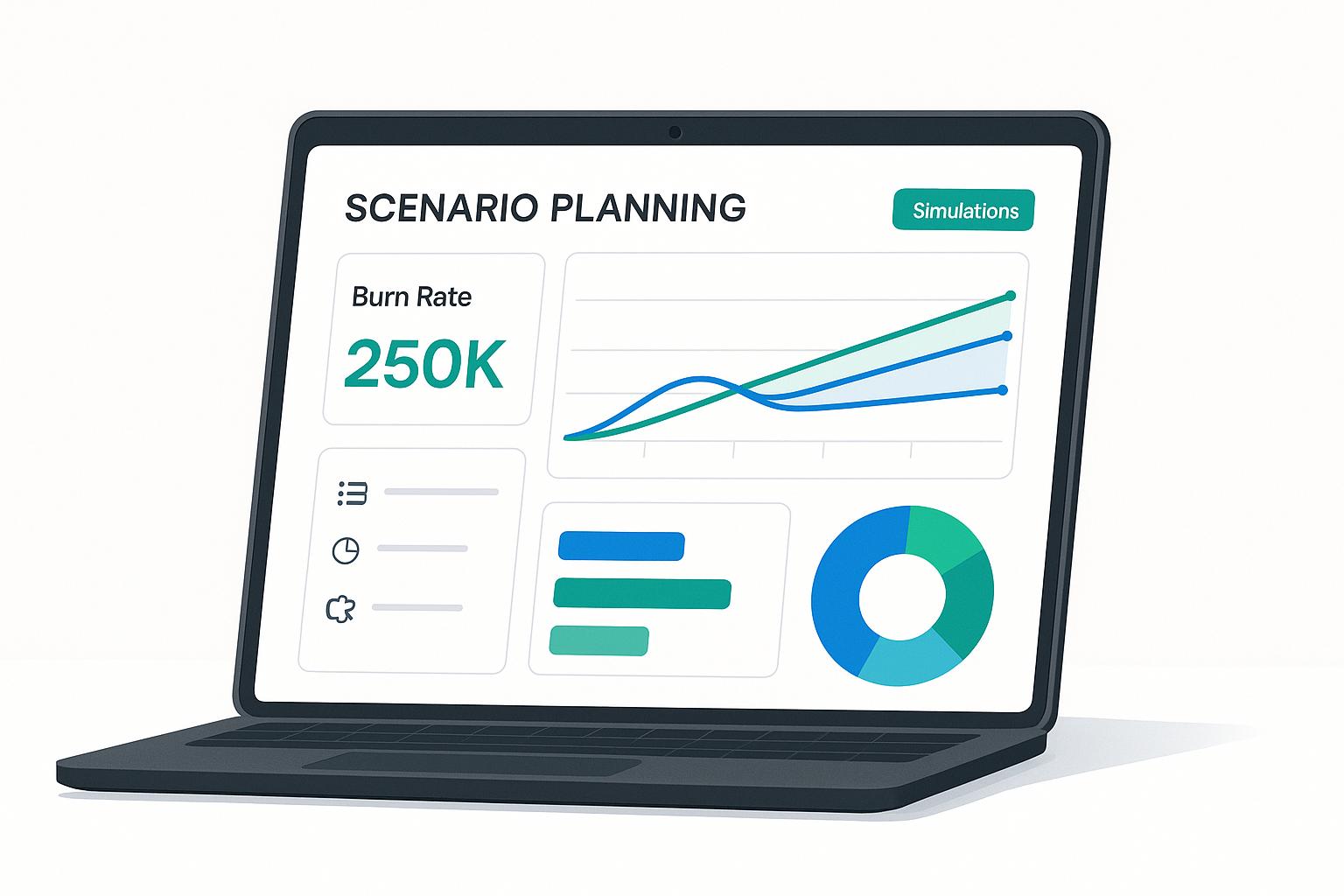Predictive analytics transforms financial planning by using data and machine learning to forecast outcomes, manage risks, and make smarter decisions. It’s especially useful for startups and small businesses to optimize cash flow, resource allocation, and customer insights. Tools like Lucid Financials integrate with platforms like QuickBooks to provide real-time analysis and planning capabilities.
Key Benefits:
- Accurate Forecasting: Analyze multiple variables for precise predictions.
- Early Risk Detection: Spot potential financial risks ahead of time.
- Smarter Decisions: Use data-driven insights for better strategies.
Quick Overview:
| Core Areas | How It Helps |
|---|---|
| Cash Flow Management | Tracks and predicts cash positions in real-time. |
| Risk Assessment | Identifies financial threats early. |
| Scenario Planning | Models multiple financial outcomes. |
Predictive analytics simplifies financial planning, turning data into actionable insights for sustainable growth.
How AI Works In Predictive Analytics For Decision Making
Core Functions and Methods
Predictive analytics transforms financial data into actionable insights by systematically collecting, analyzing, and integrating information.
Data Requirements
High-quality data is the backbone of predictive analytics. Here's a breakdown of essential data types:
| Data Type | Source | Purpose |
|---|---|---|
| Historical Financials | Accounting Software | Establish baseline patterns |
| Transactional Data | Banking Systems | Track cash flow trends |
| Market Data | External Databases | Analyze industry context |
| Performance Metrics | Internal Systems | Monitor business health |
For accurate predictions, data must be complete, consistent, and up-to-date. Automated systems that sync multiple sources in real time can help achieve this.
Analysis Methods
Once you have reliable data, use these methods to extract insights:
| Method | Application | Benefit |
|---|---|---|
| Regression Analysis | Revenue Forecasting | Identifies relationships between variables |
| Time Series Analysis | Cash Flow Prediction | Detects seasonal patterns and trends |
| Machine Learning | Risk Assessment | Finds complex patterns in large datasets |
| Decision Trees | Investment Planning | Explores multiple financial scenarios |
Software Integration
Bringing predictive analytics into your current systems makes financial planning even more effective. Platforms like Lucid Financials integrate seamlessly with tools like QuickBooks through APIs, offering:
- Real-time data synchronization
- Automated financial updates
- Instant scenario analysis
- Smooth data flow across systems
To maintain accuracy, follow strict data protocols and regularly validate your predictive models.
Common Use Cases
Predictive analytics has become a practical tool in financial operations, turning financial planning into a forward-thinking process. By relying on data-driven insights, businesses can make smarter decisions in critical areas. Here's how this technology is applied:
Cash Flow Prediction
Predictive tools make it easier for businesses to forecast cash flow, ensuring they maintain enough working capital. These tools analyze a mix of data, including:
- Historical transaction trends
- Unpaid invoices
- Seasonal fluctuations
- Payment schedules
- Broader market conditions
With this analysis, finance teams can spot potential cash shortages or surpluses ahead of time. For example, Lucid Financials uses predictive analytics to provide actionable insights, helping businesses better manage their working capital.
By anticipating cash flow needs, companies can take proactive steps to reduce financial risks.
Risk Assessment
Predictive analytics is a powerful ally in risk management, helping to identify financial threats before they occur. It analyzes patterns across various risk categories:
| Risk Type | Key Data Sources | Insights Gained |
|---|---|---|
| Market Risk | Industry trends, competitor data | Detect potential market changes |
| Credit Risk | Payment history, financial ratios | Assess likelihood of customer default |
| Operational Risk | Process metrics, error rates | Highlight internal inefficiencies |
| Liquidity Risk | Cash flow trends, debt obligations | Predict future funding needs |
By continuously monitoring these areas, businesses can act early to prevent issues, ensuring financial stability and supporting growth.
Financial Planning
Predictive analytics takes financial planning to the next level by enabling smarter scenario testing and investment analysis. Key areas of application include:
| Planning Focus | Advantages | Results |
|---|---|---|
| Budget Forecasting | More precise revenue and expense predictions | Improved resource allocation |
| Investment Analysis | Data-backed evaluation of opportunities | Maximized returns |
| Growth Planning | Scenario modeling for expansion | Better strategic decisions |
This technology replaces static spreadsheets with dynamic, AI-driven forecasting. For instance, predictive models can evaluate historical data, market conditions, and internal metrics to estimate potential risks and returns on investments.
Modern tools make these features accessible through easy-to-use interfaces, empowering businesses of all sizes to create reliable strategies and quickly adjust to market changes.
sbb-itb-17e8ec9
Available Software Solutions
Specialized software tools are now helping businesses turn predictions into action in real time, especially in the financial planning space for startups and small-to-medium businesses.
Lucid Financials

Lucid Financials combines AI-powered predictive analytics with business management tools. Here’s what it brings to the table:
| Category | Capabilities | Business Impact |
|---|---|---|
| Real-time Analytics | Integration with QuickBooks, payroll, and banking | Instant insights and financial forecasting |
| Planning Tools | Scenario modeling and comparison features | Informed, data-based decisions |
| Industry Analysis | Benchmarking against sector standards | Better strategic positioning and growth |
| Team Management | Tools for scaling teams and securing funding | Smarter resource allocation |
Lucid Financials caters to a range of needs with its pricing options, from a free plan for basic requirements to tailored enterprise-level solutions.
Essential Software Features
When choosing financial software, look for features that directly enhance your business outcomes:
| Feature | Description | Business Value |
|---|---|---|
| Data Integration | Seamlessly connects with existing financial tools | Enables thorough data analysis |
| Predictive Modeling | Uses machine learning for forecasting and planning | Delivers precise financial projections |
| User Interface | Intuitive dashboards and easy-to-use reporting | Simplifies adoption and daily usage |
Prioritize platforms that offer strong data integration, dependable forecasting, and scalability to match your business growth.
Setup and Deployment Guide
Implementation Steps
To get started with predictive analytics, begin by defining your financial objectives and ensuring your data systems are ready. Here's a practical framework to guide the process:
| Phase | Key Activities | Success Criteria |
|---|---|---|
| Data Preparation | Clean and organize historical financial data | Well-structured, accurate data |
| System Integration | Link existing financial tools (like QuickBooks) | Seamless, real-time data connections |
| Model Development | Build and train predictive models using past data | Reliable and consistent forecasts |
| Testing | Compare model predictions to actual results | Predictions align with past trends |
Once this framework is in place, focus on maintaining data accuracy and ensuring your systems work together seamlessly.
Setup Guidelines
Accurate and accessible financial data is essential. Use these key components to ensure a smooth setup:
| Component | Purpose | Implementation Focus |
|---|---|---|
| Data Validation | Maintain data quality | Regular checks and cleaning protocols |
| Integration Points | Link data sources | API setup and proper data mapping |
| User Access | Manage information flow | Role-based permissions and strong security |
| Model Training | Improve forecast accuracy | Update models regularly with fresh data |
Common Problems and Solutions
Challenges are common in predictive analytics, but they can be addressed effectively. Below are some typical issues and their solutions:
| Challenge | Impact | Solution |
|---|---|---|
| Poor Data Quality | Leads to inaccurate results | Automate data validation and cleaning tasks |
| Technical Gaps | Tools may not be used fully | Offer targeted training for your team |
| Model Drift | Forecasts lose accuracy over time | Schedule regular model updates and retraining |
Start small by piloting a project, such as cash flow forecasting, to fine-tune your methods before rolling out on a larger scale.
Wrapping It Up
Key Takeaways
Predictive analytics plays a crucial role in financial planning for startups and SMBs. By using historical data and statistical models, it helps businesses make smarter, more informed decisions.
| Component | Impact on Business |
|---|---|
| Risk Management | Helps identify and address financial risks early |
| Cash Flow Forecasting | Improves accuracy in predicting income and expenses |
| Data-Driven Planning | Creates reliable strategies based on past trends |
| Integration with Systems | Works smoothly with existing financial tools |
Incorporating predictive analytics into your systems lets businesses unlock advanced forecasting capabilities. Tools like Lucid Financials highlight how this shift is reshaping financial planning.
How to Get Started
Here’s a simple roadmap to get started:
| Phase | Key Steps | Outcome |
|---|---|---|
| Data Review | Assess the quality of your current financial data | Understand data readiness |
| Choose Tools | Pick the right analytics platform | Match tools to your business needs |
| Train Your Team | Equip your team with the right skills and resources | Build a capable, prepared team |
| Start Small | Begin with focused areas like cash flow forecasting | See measurable results early on |
The success of predictive analytics depends on using clean, high-quality data and keeping models updated as your business evolves. Start with manageable projects, and gradually expand your efforts to create a strong foundation for financial planning.
Predictive analytics isn’t just a tech upgrade - it’s a systematic way to combine past insights with forward-looking predictions for smarter decisions.

